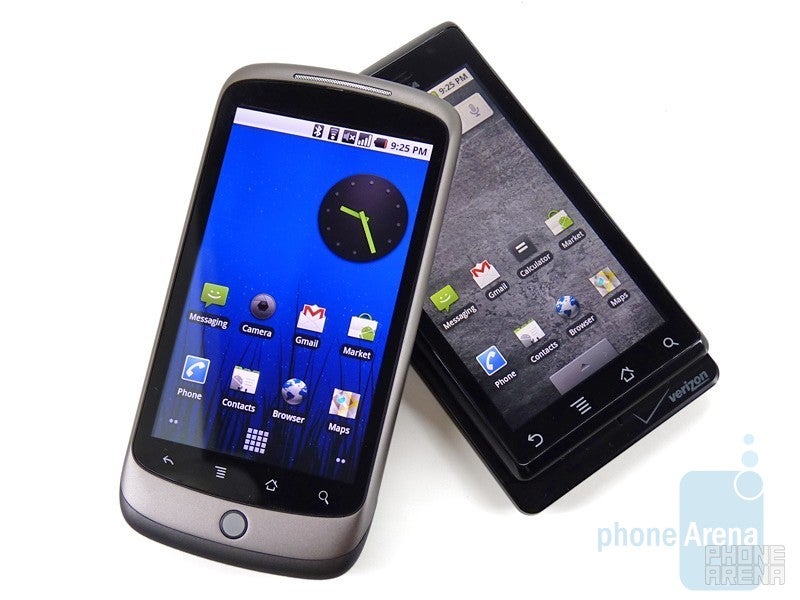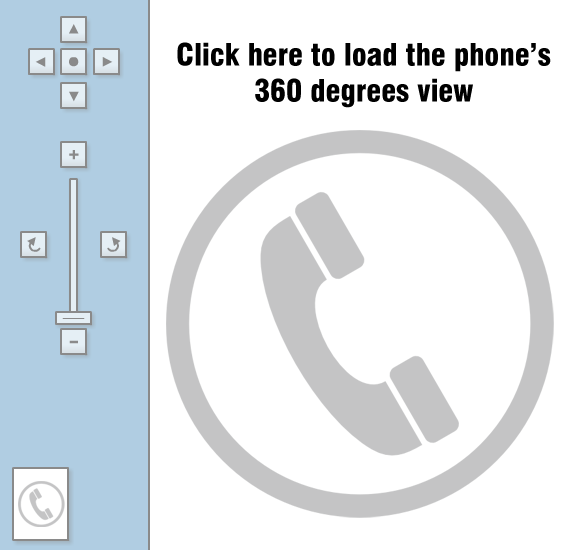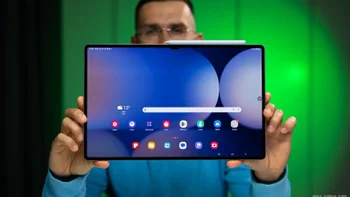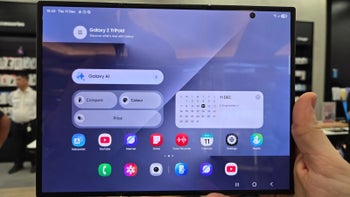HTC Nexus One and Motorola DROID: side by side

The DROID is the U.S. variant of the Motorola MILESTONE. For more information on the MILESTONE, check its review here.
Introduction:
Android has caught fire in mindshare over the past few months, thanks in part to two crucial devices running the platform: the Motorola DROID and the HTC Nexus One. The former has been blasted into our consciousness by an advertizing onslaught from Verizon Wireless, whereas the latter has been more quiet, only touting itself via web ads. With two well-spec’d devices spearheading the Android revolution the inevitable question is: “which one do I choose?”
Design:
Neither of these devices is pretty. The Nexus One is an uninspired slap of AMOLED, whereas the DROID’s gaudy black and gold color scheme gives us bad 80’s flashbacks. Both devices are dominated by their 3.7” displays, but the Nexus One wraps it in curves while the DROID frames it with right angles. In terms of display quality the Nexus One is the clear winner with its super-vibrant AMOLED panel, but the DROID is still a top 3 display on the market and manages to pack in 54 more pixels (480x854, compared to 480x800 on the Nexus One.) AMOLED allows for better brightness, making the display readable in sunlight, as well as for a much wider viewing angle. That it is less power-hungry doesn’t hurt its case either. It’s like choosing between a BMW and Ferrari; we’ll take the Prancing Horse every time, but should get stuck with the Bimmer we won’t complain.

Usually curves lead to better contouring of the hand, and sharp lines make for a less natural feel (see: GSM vs. CDMA Hero) but we actually prefer the DROID to the HTC Nexus One in our hands. The Nexus One is oddly balanced, and we found it liked to make its way to the floor more often than any phone we’ve tried. The Motorola DROID, on the other hand, fits quite comfortably and securely in our mitts. The DROID is noticeably heavier, but with a glass display and metal casing the extra heft is the result of quality materials. The Nexus One didn’t feel cheap by any means, but we almost always prefer a metal frame over plastic.
The DROID of course features a side-sliding QWERTY keyboard, something that would usually be an advantage to an all touchscreen device. Not so much here though; the keys are so flat and close together that it is almost impossible to type without looking. We actually found ourselves preferring the onscreen keyboard, and after awhile didn’t even bother to slide out the QWERTY anymore. We will say that the 5-way directional pad does offer some functionality for the gamers out there. The slide mechanism is pretty nice as a whole. Although it isn’t spring-assisted, it is super smooth and offers a perfect amount of resistance all the way through the slide until it nicely clicks into place.
In terms of buttons both are pretty identical. The DROID offers a dedicated camera key along the right side, but both have identical capacitive navigation buttons below the display, a volume rocker on the side and a power button up top. Each feature a 3.5mm headset jack and 5 megapixel cameras with LED flash. The DROID features a dual LED flash, while the Nexus One offers a dual microphone (one on the back) for active noise cancellation.
HTC Nexus One 360 Degrees View:
Motorola DROID 360 Degrees View:
Software:
We’ll keep this short because we went over Android 2.0 in depth in our DROID review, and covered the changes in 2.1 in our Nexus One review. Basically, 2.1 is a minor rework of 2.0 that brings an enhanced visual experience complete with 3D animations and Live Wallpapers. The most useful feature, however, is the new voice-to-text feature available in any text box. The server-side recognition works pretty darn well, and we only expect it to get better. A few manufacturers have tried to implement this in the past, but it never caught on due to poor results. Google has (as usual) nailed it and until other operating systems implement it this feature is a big differentiator for future Android devices.
The Motorola DROID is powered by a TI OMAP 3430 processor running at up to 600MHz, while the Nexus One has a 1GHz Qualcomm Snapdragon under the hood. Both have 512MB of flash memory, but the Nexus One doubles the DROID’s 256MB of RAM. These lead to a noticeably faster experience throughout the device and the HTC Nexus One trounces the DROID in performance, including web browsing. Like the display though, the DROID is no slouch and is still one of the faster phones we’ve ever tested.
Multimedia:
Again, there is little difference in the two devices here. The music and video players are the same in Android 2.0 and 2.1 and codec support for the two phones is almost identical (the DROID “does” OGG). Both feature 5 megapixel cameras that perform slightly above-average. Indoor pictures from both produced a significant amount of noise when viewed at full resolution. Outdoor images showed similar detail and still some noise, but were better overall. The Nexus One performed better in low light situations, and with both the flash is useful only up to a few feet away. Both record videos at 720x480; the DROID records at 24fps and the Nexus One at a minimum of 20fps, though higher if conditions allow.
We’ll keep this short because we went over Android 2.0 in depth in our DROID review, and covered the changes in 2.1 in our Nexus One review. Basically, 2.1 is a minor rework of 2.0 that brings an enhanced visual experience complete with 3D animations and Live Wallpapers. The most useful feature, however, is the new voice-to-text feature available in any text box. The server-side recognition works pretty darn well, and we only expect it to get better. A few manufacturers have tried to implement this in the past, but it never caught on due to poor results. Google has (as usual) nailed it and until other operating systems implement it this feature is a big differentiator for future Android devices.
The Motorola DROID is powered by a TI OMAP 3430 processor running at up to 600MHz, while the Nexus One has a 1GHz Qualcomm Snapdragon under the hood. Both have 512MB of flash memory, but the Nexus One doubles the DROID’s 256MB of RAM. These lead to a noticeably faster experience throughout the device and the HTC Nexus One trounces the DROID in performance, including web browsing. Like the display though, the DROID is no slouch and is still one of the faster phones we’ve ever tested.
Multimedia:
Again, there is little difference in the two devices here. The music and video players are the same in Android 2.0 and 2.1 and codec support for the two phones is almost identical (the DROID “does” OGG). Both feature 5 megapixel cameras that perform slightly above-average. Indoor pictures from both produced a significant amount of noise when viewed at full resolution. Outdoor images showed similar detail and still some noise, but were better overall. The Nexus One performed better in low light situations, and with both the flash is useful only up to a few feet away. Both record videos at 720x480; the DROID records at 24fps and the Nexus One at a minimum of 20fps, though higher if conditions allow.

To be honest neither device performed all that well when it came to call quality. Callers rated us a 7.5/10 on the Motorola DROID and said there was a lot of echo and that we sounded nasally. Callers were often asking us to repeat ourselves, and there were times we could tell they missed entire sentences from us. On our end they sounded plenty loud but hollow and we picked up an inordinate amount of background noise, easily hearing conversations going on in the background.
The HTC Nexus One was slightly better for them, and we received a rating of 8.5. We made the calls back-to-back and were told we sounded noticeably brighter and clearer- perhaps thanks to the active noise cancellation system- but that at times we became briefly unintelligible. It didn’t happen often, maybe once in a 10 minute conversation, but enough for them to notice. Our end wasn’t nearly as good; even at the highest volume they were very quiet and there was a constant static. The sweet spot for the earpiece is very small, and moving the handset just slightly on our ear would cause us to lose sound altogether. In our initial review we found that using Google Voice may contribute to these problems, but for this comparison we did not use it and still got the same results.
Conclusion:
The Motorola DROID and HTC Nexus One represent the best Android has to offer right now, and both are very similar devices. Still, the Nexus One manages to show its superiority thanks mostly to better hardware. The Snapdragon chipset makes a considerable difference in device performance, and the AMOLED display is a significant upgrade to TFT. We do like the feel of the DROID better, and in a battle of who tried to lose more the DROID came out with a better phone performance. For those that have pulled the trigger on the DROID already don’t feel bad as you have an excellent phone, but if you’re a Verizon customer on the fence right now it’ll probably be worth your while to wait a few months for the Nexus One to hit.
Follow us on Google News











Things that are NOT allowed:
To help keep our community safe and free from spam, we apply temporary limits to newly created accounts: